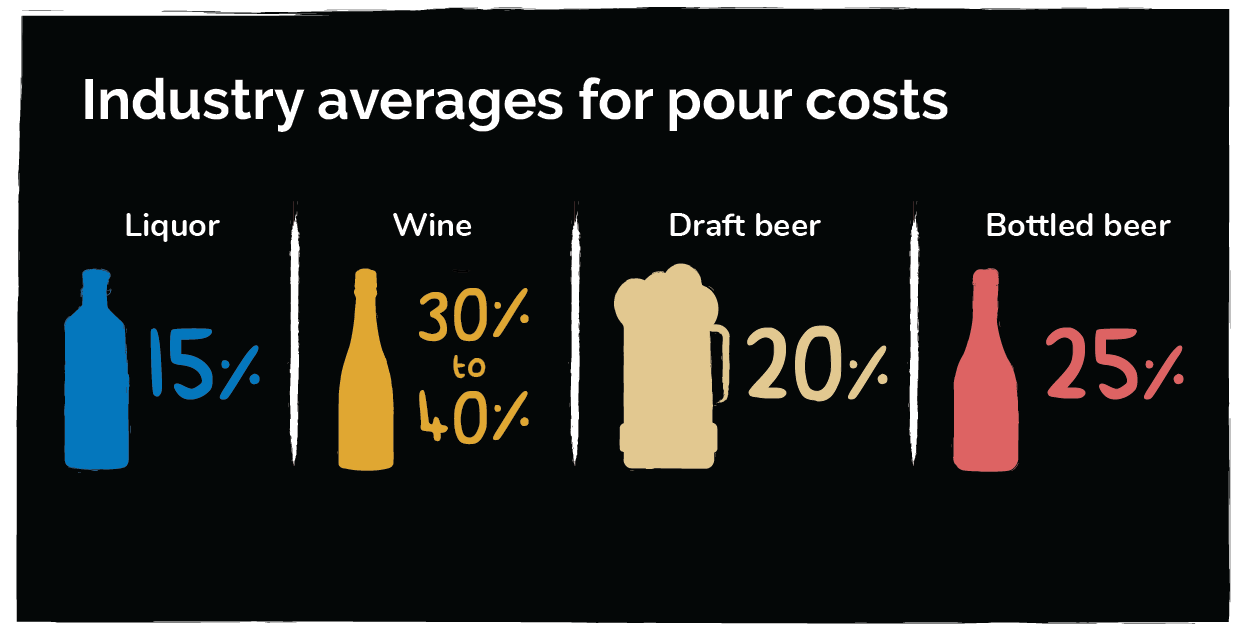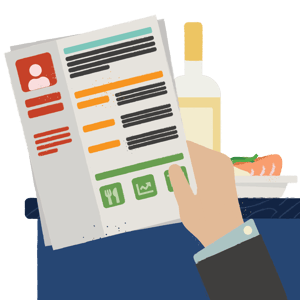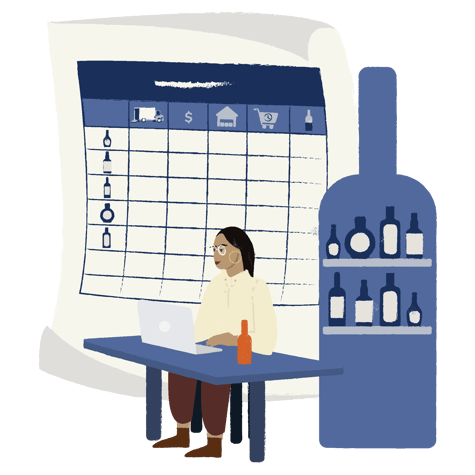Being a bar manager requires a lot more math and brain power than you may think.
"This isn't what I signed up for!" you might be shouting over a pile of spreadsheets and invoices, but tracking data is an essential aspect of running a bar—without it, you'll be lost in the weeds.
Think of tracking your bar data like making a great cocktail; each ingredient has to be carefully measured and accounted for in order to create a harmonious end result.
However, if you decide to aimlessly throw ingredients into a cocktail shaker without any prior planning, you'll probably end up with an incoherent mess (also, it will taste bad).
That's what happens to your bar program when you don't do the books. Consistently tracking your data—such as your COGS, usage rates, and par levels—will help you avoid a lot of costly mistakes.
If you want to keep your bar running at peak performance, here is a roundup of the most important data points you should be tracking.
1. Cost of Goods Sold
Cost of Goods Sold (COGS) is an essential metric that will help you assess the overall health of your bar. Knowing your COGS will also allow you to track other important data points, such as your liquor cost percentage.

By definition, your COGS is the cost associated with the amount of inventory you sold during a given time period. And this includes all of the raw materials that are needed to get a dish or a drink to the table—so straws, garnishes, condiments, and spices should be included when you calculate your COGS.
Knowing your COGS will help you maintain budgets, set menu prices, and avoid spending too much on your inventory.
How Do I Lower My COGS?:
Less money spent on inventory means more money for your bottom line. However, you shouldn't aim to spend too little, as that may mean you're compromising on quality.
Instead, look for ways to leverage your inventory to your advantage. Buy in bulk wherever it makes sense to do so, and shop around for the best deals from vendors. You can oftentimes cut a deal with distributors you have a longstanding relationship with.
2. Liquor Cost Percentage
Your liquor cost (sometimes referred to as pour cost) is how much you pay to purchase alcohol from your vendors. Your liquor cost percentage is how much you're spending versus how much profit you're generating from liquor sales.
Pour costs will vary depending on your concept and your menu, but here are some of the industry averages you can expect to see across the board.

How Do I Lower My Liquor Costs?:
Try to limit liquor loss by adding a few pre-batched cocktails to your menu. It will give you added precision over your drink recipes, and greatly reduce spillage, mistakes, and overpouring.
Liquor has very high profit margins, so losing even an ounce of it to overpouring can cost you thousands of dollars per year. By pre-batching certain cocktails, and ensuring your bartenders are properly trained, you can easily take control of your pour costs.
3. Labor Costs
A great staff is your greatest asset—but it's also going to cost you. Staffing a restaurant can end up costing you anywhere from 30-35% of your revenue, depending on the type of concept you're working with.
Keep in mind, your total labor costs include things like staff salaries, hourly pay, PTO, health insurance, and more. If you don't keep labor costs in check, they can quickly eat into your profits.
 How Can I Lower My Labor Costs?:
How Can I Lower My Labor Costs?:
For starters, you should assess where your turnover rate is at. High turnover costs bars and restaurants thousands of dollars per year. A low turnover rate and happy employees will keep your labor costs low.
Also, make sure you are staffed appropriately. Overstaffing can eat into your profits, as well as the tips of your serving staff. Staffing adequately will allow you and your employees to take home more money at the end of a shift.
4. Prime Costs
Your prime costs are a combination of your two biggest costs—COGS (food and liquor) plus your total labor costs. Your prime cost will typically cost you about 60% of your revenue.
Keeping food, liquor, and labor costs in check is quite possibly the most important aspect of running your bar, as these will make up the lion's share of your expenses.
How Do I Lower My Prime Costs?:
Ensure that your FOH and BOH staff are using correct portions as they prepare food and drinks. Also, consider using ingredients that can do double duty and be reused. Leftover fruit and veggies can be great for making fresh juices behind the bar.
And again, be sure to monitor your turnover rates. If employees keep walking out the door, then you have a retention problem that will continue to add to your prime costs.
4. Usage Rate
Your inventory usage rate is the pace at which you sell through your product—essentially, it's how quickly your inventory is moving out the door.
Knowing your usage rate can help you set your par levels, budgets, and reduce excess inventory. Here is the formula we use to calculate usage rates:
Opening Inventory + Purchases Received - Closing Inventory
= Inventory Usage
5. Par Levels
Your par level is the minimum amount of inventory needed to meet your customer demand.
Why is it so important? Getting those par levels in check will help you avert two common scenarios that bar managers want to avoid at all costs; not having enough product to get through the week, or having too much excess stock in your inventory.

Both scenarios are equally bad for your bottom line—having too much stock means you're tying up extra money in your inventory, whereas not having enough on hand means you're disappointing your customers.
Once you set your par levels, you'll know how much product to order, as well as how often you should order it.
Your pars can fluctuate due to a variety of factors (the changing of seasons is a big one), so it's important to take consistent and accurate inventory so you know where your par levels stand.
How Can I Set My Par Levels?:
To get started, print out reports from your POS system to gain sales data. You can also study your previous order history with vendors. Use Backbar's free par level worksheet to get started on mapping out your pars.
6. Weekly or Monthly Budget
Mapping out your budgets (and sticking to them) will help you create consistency within your bar program. Your budget will vary depending on the time of year and your restaurant concept—for example, you may be spending more money in the summer if you run a bustling patio in a warm location.
In order to set a proper budget, you need to be able to track your sales, as well as estimate future sales. Your POS system can tell you a lot about your sales trends, and give you a good starting point when it comes to setting a monthly or weekly budget.
How Should I Set My Budgets?:
As always, set aside some cash for any surprise expenses that may arise. Replacing equipment and making customary repairs can cost you thousands of dollars. Ensure that you have the cash flow to cover these bills.
7. Inventory Variance
Your inventory variance is your shrinkage, or loss. It's product that should be there, but isn't. This loss can occur due to a variety of factors—theft, over pouring, spills, and more.
Knowing your inventory variance can tell you if there is an issue, but it will take some sleuthing skills on your part to discern where the shrinkage is coming from. However, knowing there is an issue is half the battle.
 How Do I Control Inventory Variance?:
How Do I Control Inventory Variance?:
Much like liquor costs, a few pre-batched cocktails can help you with inventory variance. It reduces the chances of product loss and gives you more control over your ingredients.
Taking consistent inventory will also tell you immediately when a variance occurs, and give you the chance to stop it.
How to Keep Track of Important Data With Software
Now that we've covered what you should be tracking, what is the easiest way to calculate all of this? Are you still screaming over those spreadsheets and invoices in your tiny office?
We're here to help. Surely, you can't do it alone. Software will help you track these metrics, without giving you the headache.
Backbar's Free Bar Inventory Software
A reliable bar inventory software is the fastest and easiest way to track your bar's essential data.
Imagine trying to add up your COGS, par levels, usage rates, and labor costs entirely by hand—it's nearly impossible to do so. That's where we come in.
Backbar not only streamlines your inventory process, we also offer you detailed inventory reports that will allow you to understand the health of your bar program. Every time you conduct your inventory with Backbar, we generate customized reports that will tell you your usage rates, COGS, and more.

If you're ready to ditch the spreadsheets, Backbar is currently offering a 6 month free trial of our Essential Plan. Give us a try today, and see for yourself how Backbar can transform your bar program.




